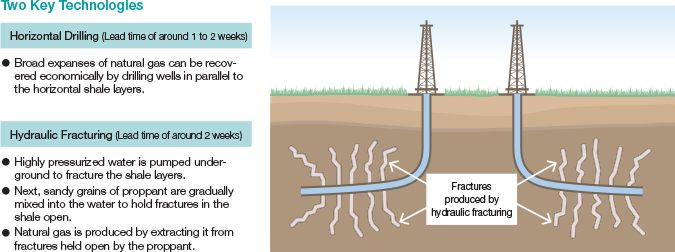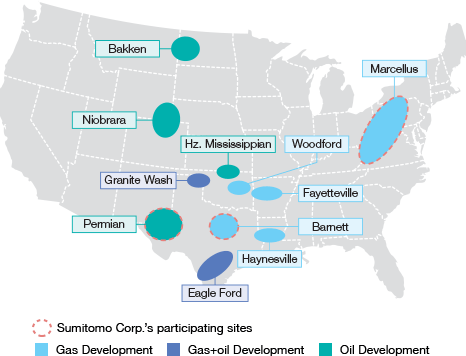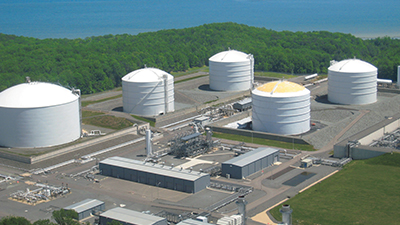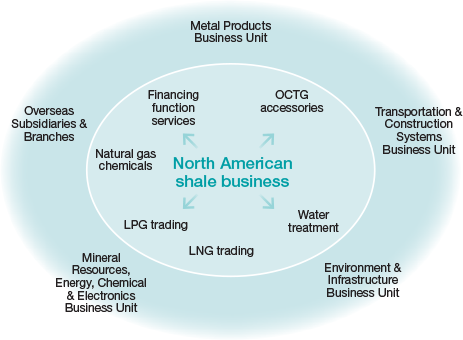Expansion in Scope of the
unconventional Energy Businesses- Expanding the Agricultural
Materials Value Chain>


The U.S. energy situation changed overnight with the successful extraction of shale gas. Until the mid-2000s the U.S. had been expected to become the world’s largest importer of natural gas, but with the revolution of shale gas the country is now poised to become an exporter of liquefied natural gas (LNG).
Shale is a rock formed from hardened horizontal layers of mud, and shale gas is a hydrocarbon gas stored within spaces in the shale. It has long been known that shale gas exists throughout the world. However, commercial production had not been feasible because previous drilling technologies alone were not really up to the task of bringing shale gas to the surface. The U.S. was the first to successfully develop technology for the job. Entering the 2000s, horizontal drilling and hydraulic fracturing technologies were established that vastly improved shale gas productivity. From around 2006, full-scale commercial production of shale gas began. Before shale gas development was achieved, natural gas suppliers were concentrated in the Middle East. The advance of shale gas development throughout the U.S. has since been transforming the global natural gas market landscape.


Sumitomo Corporation’s exploration and production (E&P) business had until now been focused on oil fields in British and Norwegian zones of the North Sea as core assets. In pursuing the possibility of building up our prime assets further, we began seeing great potential in shale gas, as it is driving the transformation of the oil and gas development industry. In December 2009, Sumitomo Corporation became the first Asian company in shale gas development by agreeing to participate in a project being led by Carrizo Oil & Gas, Inc. in the Barnett Shale Fields in the leading shale gas producing state of Texas, U.S.
We also joined the Marcellus Shale Fields development project in Pennsylvania in September 2010. The Marcellus project plans call for at least 1,100 wells to be drilled by 2020.
Sumitomo Corporation’s oil and gas development business is delving even further into unconventional crude oil (tight oil) development. Tight oil is crude oil contained in shale, limestone and sandstone formations with low permeability. As with shale gas, it is extracted using horizontal drilling and hydraulic fracturing technologies. In September 2012, we signed an agreement to participate in Devon Energy Corporation’s tight oil development project in the Permian Basin in Texas. The project will fuel dramatic longer-term earnings advances for us as it has enhanced our oil and gas assets, which we have positioned as a key strategic resource within our portfolio strategy for upstream resource and energy operations.
The project’s development area is the Permian Basin, which boasts the largest proven oil reserves in North America and accounts for 20% of total crude oil production in the U.S. As shale gas and tight oil development technology has advanced, the Permian Basin has come to be one of the most active development areas in the entire U.S. In addition, our partner Devon Energy Corporation has pioneered shale development, for instance by being the first in the industry to use horizontal drilling technology in development. It is currently a top operator with outstanding technological experience and know-how.
We are forging ahead with leading partners in such promising development areas with high potential. Our goal is to establish ourselves as a leading Japanese company in unconventional energy development by building on the unconventional energy-related expertise, insight, and industry presence, which are the strengths we have gained through the Barnett and Marcellus shale projects.
Shale gas, tight oil, and other unconventional energy operations entail an array of functions in every part of the process from the upstream through the midstream including drilling, production, and transportation. Sumitomo Corporation is ascertaining these needs and going beyond upstream development to leverage its strengths and put its collective abilities into play to realize multidimensional business development.
 Pipe cutting process at a U.S. seamless steel pipe manufacturing subsidiary
Pipe cutting process at a U.S. seamless steel pipe manufacturing subsidiary
About 12 million tons of oil country tubular goods (OCTG) are consumed worldwide each year. Half of this, or about six million tons, is used in the U.S.—making it the world’s largest OCTG market.
Sumitomo Corporation has long been in the business in North America, having made a full-fledged entry into tubular products distribution 25 years ago. Against a backdrop of thriving shale gas and oil development, we have since expanded our operations centered on our proprietary distribution network into areas such as manufacturing and processing while meeting changing customer needs. We now command a roughly 20% share of the North American OCTG market.
In this OCTG market, demand for small-diameter tubular goods has surged since around 2007 in line with the rise in shale gas and oil development in which they are used. This spurred us to participate in a small-diameter seamless steel pipe manufacturing business led by major French steel pipe producer Vallourec S.A. in September 2011. Operations commenced in fall 2012. We plan to reach full capacity production in 2013 with annual steel pipe output of about 350,000 tons, and aim to further expand our share of the OCTG business.
Additionally, we acquired the Howco Group at the end of 2006 to gain a foothold in oil field equipment (OFE), the field adjacent to the OCTG business. The revolutionary rise in shale gas and oil production has made OFE a huge market currently worth ¥40 trillion. We will employ Howco’s oil field equipment processing and distribution capabilities to capture this demand.
Sumitomo Corporation’s North American tubular product business is built on three strengths: 1) an extensive customer base centered on long-term contracts with a broad range of oil companies, from the majors to small- and medium-sized independent firms; 2) a distribution network enabling just-in-time supply of high quality products; and 3) a support system for smooth operations based on a proprietary IT system, including an OCTG supply chain management system. Along with reinforcing this foundation, we will augment our tubular product business role as a total solutions provider covering upstream through midstream operations by growing our OFE business driven by Howco as well as our line pipe and specialty tubular products operations.
 Dominion’s Cove Point LNG terminal
Dominion’s Cove Point LNG terminal
In April 2013, Sumitomo Corporation agreed to participate in the Cove Point LNG Project in Lusby, Maryland, planned by Dominion Cove Point LNG, LP (Dominion). The project entails building a new natural gas liquefaction plant at the existing Cove Point LNG Terminal currently in operation as a LNG receiving terminal. The plant will be used to produce LNG for export from domestic natural gas, including shale gas. The goal is to commence operations in 2017 after completing procedures including receiving approval from the U.S. Department of Energy to export LNG to countries without free-trade agreements with the U.S. Sumitomo Corporation concluded an agreement via its wholly owned subsidiary Pacific Summit Energy LLC (PSE) with Dominion to liquefy around 2.3 million tons of natural gas a year. Sumitomo Corporation also entered into basic agreements to sell the LNG produced from the project to Tokyo Gas Co., Ltd. and Kansai Electric Power Co., Inc. over a 20-year period starting in 2017.
In 2004, we established PSE and began our natural gas trading and marketing business in the U.S. We have grown to become the only 100% Japanese-invested firm player with annual natural gas trading activity in the U.S. on a scale equivalent to 10 million tons of LNG. PSE’s role in the Cove Point LNG Project is to combine diverse resources from the U.S. natural gas market and Sumitomo Corporation’s interests to supply the liquefaction plant with a steady stream of competitively priced natural gas over the long term.
By capitalizing on expertise in natural gas trading and strengths in gas procurement gained through the abovementioned shale upstream development and PSE operations, the project aims to build a natural gas and LNG value chain from shale gas development to distribution, liquefaction, and export. Sumitomo Corporation will use this value chain as a foundation to supply Japan with LNG linked to U.S. natural gas prices in a bid to diversify Japan’s LNG supply and procurement pricing formulas, thereby contributing to Japan’s energy security.

This is only a single example. The areas of unconventional energy business where our strengths can be applied are far reaching. For instance, hydraulic fracturing in shale gas and oil development requires a tremendous amount of water. Chemicals—albeit a small amount—are added to this water, so the wastewater cannot be disposed of directly into waterways. The wastewater must either be disposed of into dedicated wells or treated before being discharged or recycled. Demand for wastewater treatment and recycling is expected to rise to protect the environment. The Environment & Infrastructure Business Unit is exploring steps based on its track record and know-how in water treatment overseas to meet these anticipated needs. Further, shale gas and oil production generates byproducts such as ethane, propane, and butane. The Mineral Resources, Energy, Chemical & Electronics Business Unit is working to leverage its many years of trading experience to put these byproducts to use in expanding petrochemicals and LPG operations.
In September 2012, we launched a working group spanning the entire organization for unconventional energy businesses. We strengthened ties not only with marketing departments but also with overseas bases. We also established a framework for global information sharing to uncover new business and investment opportunities. Moreover, our medium-term management plan, Be the Best, Be the One 2014, calls for strategic investment in unconventional energy-related businesses as a strategic industrial focus for the entire Group. We will seize business opportunities arising from the major paradigm shift brought about by the shale revolution. Specifically, we will establish a new business pillar by combining our strengths and abilities, and unleashing our integrated corporate strength to expand the scope of our unconventional energy businesses.